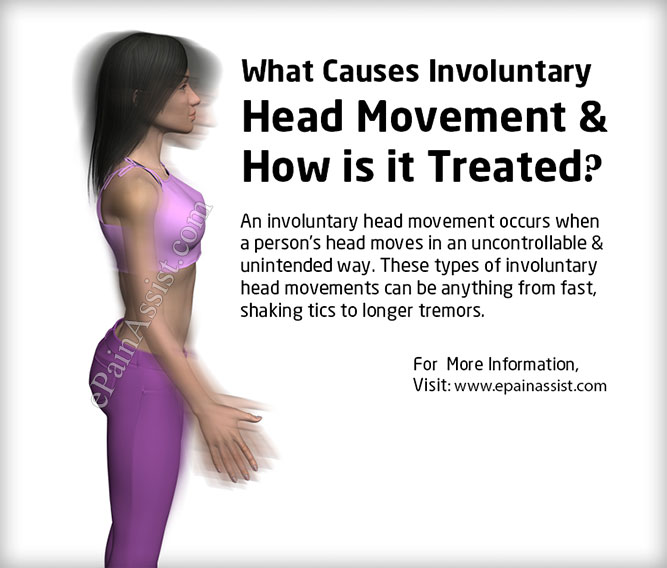An involuntary head movement occurs when a person’s head moves in an uncontrollable and unintended way. These types of involuntary head movements can be anything from fast, shaking tics to longer tremors. There are different types of involuntary head movements and causes of such movements. Sometimes, this involuntary head movement is also called essential tremor (ET) or Abnormal Involuntary Movement (AIM). Apart from the head, hands, arms, larynx, tongue, and chin may also be affected by the same issue. In most of the cases, involuntary head movement is not a life-threatening issue. Most of the patients can spend their life normally with some slight modifications in lifestyle. Patients with problems in eating, writing or speaking, quickly learn to cope with this problem by suitably adjusting their activities.

Symptoms of Involuntary Head Movement
The most visible symptoms of involuntary head movement are as follows –
- Uncontrollable and unintentional shaking of the head that may persist for a brief period or it may be continuous
- Shaking of voice can also be an accompanied symptom of involuntary head movement
- Continuous nodding of the head
- Tremors that increase while doing physical activities, or decreases after taking some rest.
- Tremors increases remarkably in stressful situations.
What Causes of Involuntary Head Movement?
The root cause of involuntary head movement is still unknown to the researchers, but it is assumed that some abnormal neurological activities in the brain cause this problem, and primarily the thalamus region of the brain is responsible for essential tremor.1 The thalamus is a part of the brain that coordinates and controls the muscular activities of the body. This is the reason for which researchers have primarily assumed that it is the source of involuntary head movement.
It is further noticed by the experts that genetics has a close relationship with involuntary head movement. A child of the parents with this problem has high risk of inheriting the gene causing involuntary head movement.
Apart from the above causes, some other common causes of involuntary head movement may be the following ones –
- Any kind of brain injury
- Stroke
- Brain tumors
- Diseases related to thyroid hormone secretion
- Degenerative disorders like Parkinson’s disease
- Untreated syphilis
Children may also get this problem mainly due to hypoxia, cerebral palsy and insufficient oxygen in the brain.
Age Group at Risk for Involuntary Head Movement
Normally people above the age of 40 years get affected with involuntary head movement, and as a person ages, his or her risk of having this illness increases.
Though the experts have found a genetic link of this disease, many people didn’t get affected even when one or more of their ancestors have been detected with the problem.
Some Allied Factors Behind Involuntary Head Movement
It is often noticed that people with other physical and neurological disorders like Parkinson’s disease, Alzheimer’s disease also get this problem of involuntary head movement. In addition, extremes of fatigue after sports competition and in extreme emotional stress many people often face problems of involuntary head movement. Moreover, the problem may also surface due to side-effects of some prescription drugs, and in cases of metabolic abnormalities, etc.
Diagnosis of Involuntary Head Movement
Diagnosis is primarily based on symptoms and relevant neurological examination. There is no specific blood or urine testing process for the diagnosis of this condition. However, tests for thyroid, liver function, kidney function, and side effects of drugs may be undertaken by a physician depending on the condition of the patient.
So, diagnosis for involuntary head movement includes any one or more of the following tests –
- Electrolyte studies
- Thyroid function test
- Complete Haemogram
- Serum calcium test and serum copper test
- Syphilis serology
- Urine test to detect the presence of toxin materials
- Spinal fluid analysis
- MRI or CT scan to detect physical abnormalities in the brain
- Electroencephalogram
- Different psychopharmacological testing depending on the condition and history are often advised by the neurologists.
How is Involuntary Head Movement Treated?
This problem of involuntary head movement occurs basically due to improper coordination between the brain and muscles. So, neurologists often advise for different physiological activities, like walking, swimming, outdoor games, gardening, etc. They also ask the patients to practice exercises under expert supervision. This sort of activities improves neurological function. In case of mild involuntary head movement, problems mostly improve through physical activities. However, these can’t be advised to every patient such as aged patients with some other physical or neurological issues.
In such situations, neurologists and other experts mostly advise medications or surgeries:
- Medications for Involuntary Head Movement: Several oral drugs are prescribed depending on the condition and allied issue. Drugs like Mysolin, Neurontin, and tranquilizers are often used for this disease.
- Surgery for Involuntary Head Movement: Patients with severe involuntary head movement are advised for Deep Brain Simulation (DBS), which helps in better muscle control and enhanced brain activities.
Many researches are going on to invent more authentic ways to treat involuntary head movement; however, no specific cure is available for this disease till date. Treatment procedures mentioned above can only prevent the problem of involuntary head movement from progressing further.
Conclusion
Involuntary head movement is not a life-threatening condition; however it causes great discomfort in the person experiencing it. There is no specific diagnosis process or treatment procedure available for involuntary head movement. Current treatment procedures can only improve the symptoms or hinder the further progress of this annoying health problem. Some physical activities, including outdoor games and exercises can control the problem to a great extent, especially in case of mild involuntary head movement. It is always feasible to stay physically active as much as possible, and follow the doctors’ advice to lead a normal lifestyle and control the disease.
Also Read:
